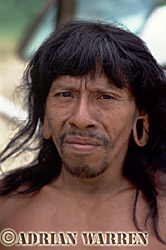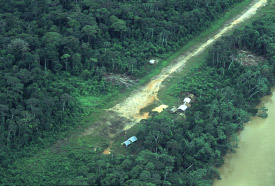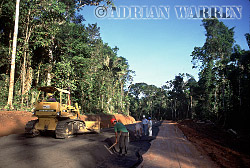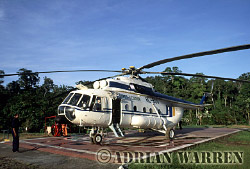WAORANI
The Saga of Ecuador's Secret People:
A Historical Perspective
© Adrian Warren, Last
Refuge Ltd., March 2002, in association with Dr. James Yost
In desperation, representatives
of nearly all Waorani communities travelled to Tonaempaedi. There they
held a series of meetings intending to establish their own independent
organisation, ONHAE, in order to interface directly with the now numerous
interests of outsiders impinging on their lives and their territory.
With increasing dependence on outsiders, money was beginning to assume
an importance the Waorani never previously understood. At the meetings,
feelings were strongly divided; some speakers saw advantages with the
oil companies as a source of income, others complained that the few
dollars they received was very small in comparison to the value of the
damage inflicted, and the resources being removed from their land.

Tedecawae, 1993 |
From the beginning, a headlong
scramble to access manufactured goods like clothing, axes and machetes
had drawn Waorani into oil company contact. Even back in 1974, in
the hopes of luring helicopters and their booty, Caempaede's group,
at Gabado, built helipads with mock scribbling on sticks in imitation
of helipad markers. A man called Tedecawae even composed a new song
about helicopters in the hopes that singing it would induce helicopters
to come bearing gifts. For nearly two decades the Waorani welcomed
oil exploration because the seismic lines cleared by company crews
made excellent trails for travel or hunting. In addition, the massive
wealth of goods, food and new experiences attracted Waorani to seek
employment with oil companies as labourers. |
The encroachment was increasing
the pressure on the now confused Waorani to integrate. Caempaede's
group moved back to the Cononaco airstrip where, in spite of the risk
of diseases brought in by outsiders, they believed they would have
more access to material goods; air transport for medical care; and
access to schools. Little by little, as all these things began to
assume an importance unknown before, they were losing their independence. |

Caempaede's
settlement at Cononaco airstrip
|

A new Oil Company Road in WAORANI
INDIANS Territory, Ecuador, 1993 |
The oil companies
continued their encroachment on traditional lands, and the first road
was constructed with astonishing speed in 1982. The road, in itself,
was relatively benign. But, like the wake from a tanker, it brought
with it wave after wave of colonists seeking wealth or escape from
trouble elsewhere. Quichuas from the Andes, Quichuas from the rain
forest, blacks and mestizos from the Ecuadorian coast, Shuar from
the Ecuadorian-Peruvian border, Colombians of various stripes - they
all invaded with the persistence of a horde of army ants, consuming
the forest in their path. In the vanguard, clearing the way for all
of these were an aggressive pack who have low regard for life in general,
but for Indians and Waorani in particular. The Waorani were pushed
farther and farther into the recesses of the forest. |
The disturbance of a massive influx of outside
civilisation in some areas frightened away game animals the Waorani needed
to hunt for food, and brought yet more diseases. The history of contact
between outside civilisation and indigenous peoples is replete with epidemics
taking a heavy toll. The Waorani were fortunate in that the missionaries
provided medical treatment and stayed long enough to ensure that epidemics
did not decimate them. At one time they were the only line of modern health-care
for the Waorani, and today they are still the principal source, particularly
for accidents and snakebite. The diseases the Waorani face today give
ample testimony that as a people they are inextricably entwined into the
international community. The latest strains of colds or influenza quickly
find their way into Waorani villages. Most recently, Hepatitis D, Cerebral
Malaria, and Chicken Pox, all unknown only a decade ago, have swept through
Waorani communities as a result of tourist visits and Waorani travels
or work among the cowode.

Maxus Oil company helicopter,
Waorani territory, Ecuador, 1993
|
